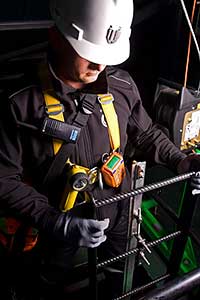
by Alison Smith, Marketing Director, Crowcon
The water and wastewater industries produce many toxic and flammable gases that need to be detected and eliminated. The gas hazards vary considerably depending on the application, location and treatment process, but the solution is always the same – a combination of fixed and portable gas detectors.
At each stage in the processing and treatment regime – for both water and wastewater – there will be variety of gas  hazards. Some of these hazards will be common to most if not all facilities, while in many cases there will be peripheral or specialised treatment processes unique to a particular site, with its own unique gas detection requirements. In the majority of cases both fixed and portable gas detectors will be required.
hazards. Some of these hazards will be common to most if not all facilities, while in many cases there will be peripheral or specialised treatment processes unique to a particular site, with its own unique gas detection requirements. In the majority of cases both fixed and portable gas detectors will be required.
It is important to recognise that gas detectors are not simply installed for process monitoring – they are required to save lives. However, this life saving equipment must also be robustly constructed to survive the rigours of deployment in a water plant. A variety of harsh environments can exist, from unpredictable water levels and physical damage, to the acidic or caustic conditions which result from gases such as hydrogen sulphide or chlorine mixing with water.
Drinking water facilities
In drinking water facilities gas hazards include chlorine, sulphur dioxide, ammonia, ozone and chlorine dioxide, originating from locations such as gas storage areas, gas dosing plant and ozone generators.
Most pre-treatment of drinking water is a physical process involving flocculation, filtration and ion exchange and it is only at the treatment/disinfection stage that chemicals are used, with the resulting gas hazards. Chlorine is the traditional disinfectant used in water treatment – in most countries it is a legal requirement, even if other non-chemical methods (such as UV disinfection) are used, as it provides residual disinfection downstream. Everything in the chlorination process, from the chlorine gas storage tanks to the final production of clean water, should be properly monitored. This includes valves and any rooms the chlorine pipes pass through.
While chlorination is still the treatment method of choice in most water works, some are now switching to alternative methods such as ozone, chlorine dioxide or sodium hypochlorite. In addition, in those plants that still use chlorine, sulphur dioxide is often used to dechlorinate the water when treatment is complete. All the above mentioned gases are hazardous and should be effectively monitored. Sulphur dioxide needs only very low concentrations to be a danger to life, while chlorine is a very heavy gas and is readily absorbed by most materials, making it difficult to detect in storage areas. Concerns have also been raised recently about the levels of carbon dioxide in confided spaces in chalk areas.
Due to the differences not only in gas hazards but also in the human presence in certain parts of a water treatment plant, a combination of both portable and fixed gas detectors are usually required. Gas storage areas, ozone generators, rooms that gases pass through, as well as the treatment plant, should always have fixed detectors installed for the particular gas (or combination of gases) in use. In addition, portable detectors should always be mandatory when operators enter confined spaces where these gases can be present – even if fixed detectors are installed – as a safe back-up. Again, depending on requirements, these can be single or multi-gas portable detectors.
Wastewater treatment facilities
In wastewater facilities there are many gas hazards, including methane (a flammable gas), oxygen, hydrogen sulphide, chlorine, carbon monoxide and carbon dioxide. These gases originate from many sources, such as sewers, pumping stations, aeration tanks, sludge digester tanks, deodorising plant and treatment plants.
Primary and secondary treatment processes such as aerating and sludge digestion are some of the ‘high risk’ areas where biogases from sludge, including methane, hydrogen sulphide, oxygen and carbon dioxide are a hazard. Apart from being highly explosive, methane also displaces oxygen, increasing the risk of asphyxiation. Hydrogen sulphide, on the other hand, has a distinctive odour at low concentrations (0.0047ppm), but as levels increase to over 150ppm the olfactory nerves are damaged, masking the danger from workers, who will not be able to smell the gas even if it reaches the lethal concentration of 800ppm. Biogas from sludge digestion is used for electricity generation and, because it is highly flammable, any leak from a digestor is very dangerous and could lead to an explosion.
As with drinking water treatment, wastewater is also usually treated with chlorine (or chlorine alternatives) before it leaves the plant, so the same gas monitoring procedures should be rigorously followed from storage through to final treatment.
Flammable fixed gas detectors are required for installations such as sewage inlets and wet wells, where one of the biggest risks comes from the emptying of flammable liquids into drains, which float on the surface and collect in the wet well where they can reach a flammable level. Methane, carbon dioxide, oxygen and hydrogen sulphide fixed detectors should also be fitted in all sludge aeration and processing areas. In addition, deodorising plants need fixed high and low concentration hydrogen sulphide monitoring. Portable gas detectors should be worn by operators entering any confined spaces, including sewers, pumping stations, sludge digestors and treatment plants. Multi-gas monitors are the norm in these situations.
Conclusion
Every gas has its own characteristics, so fixed and portable gas detectors should be located or worn wherever they will have the best potential for monitoring a gas build-up (or gas depletion in the case of oxygen). The water and wastewater industries, like other industries, are constantly looking at ways to save costs. Worker safety, however, should never be compromised; gas accidents in these industries do not simply cause injuries – they kill. As part of a comprehensive safety programme, gas detection should therefore be given a high priority and be based on industry best practices. This will go a long way to ensuring the safety of all workers – even in the most hazardous locations.






